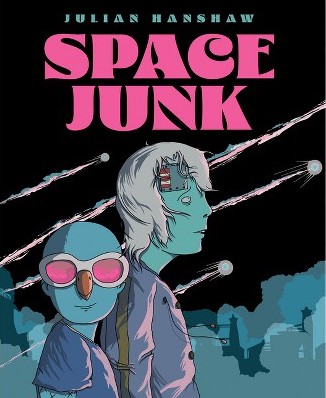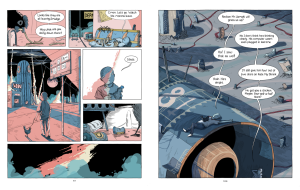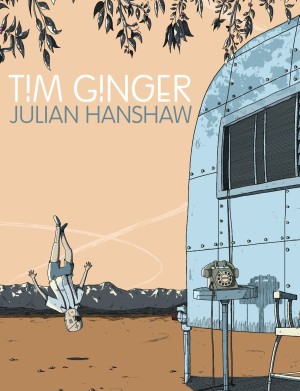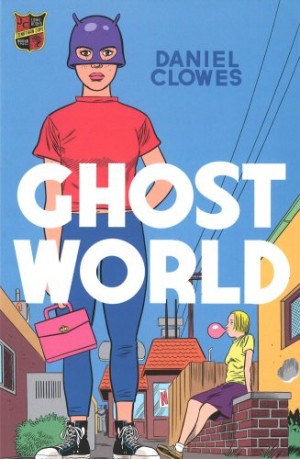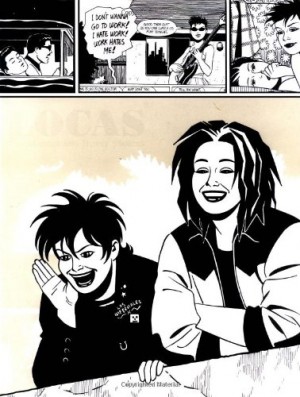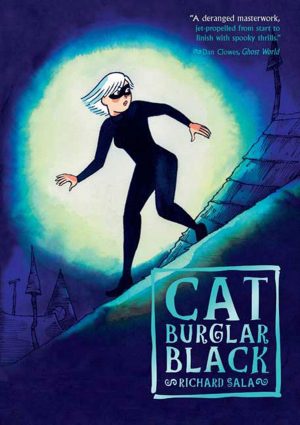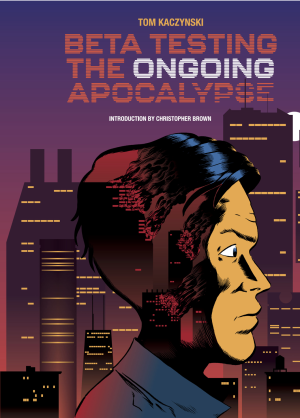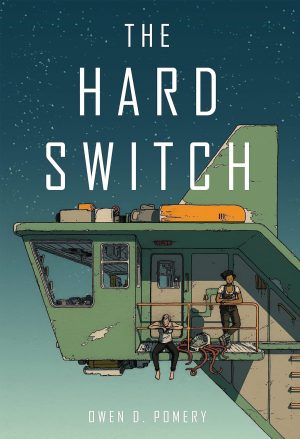Review by Graham Johnstone
Space Junk is set on a planet reaching the end of its economic viability. That planet is never named – simply the latest dormitory for precarious workers plundering the planet for (someone else’s) profit. It teases both an irreverent take on tech, and the trashing of new territories.
Writer/artist Julian Hanshaw, has already proven himself a sharp social observer and speculator, and able to play out the political through the personal. In 2022’s Free Pass, he used technology to fuel a fresh take on human desires and responsibilities. There mid-lifers struggle to keep it fresh, while Space Junk focusses to youngsters seeking… well, they’re not sure what.
Hanshaw sets up his scenario well. A promotional film by Mondo Corp introduces the premise: “Time to move onto the next planet.” The film, with its talk of ‘adult supervisors’, seems aimed at young people – not yet cogs in the machine, but expected to ship out and join their parents. Faith, a teenage girl watching the film in what seems a cinema is sceptical. Having set up the conflict, Hanshaw wittily establishes its urgency, with the cinema proving to be a shipping container suddenly hoisted up for transportation to the next planet.
The book is a two-hander between Faith and fellow loner/refusenik Hoshi. Faith has a scrap of space junk in her head, creating the dubious ‘super-power’ of uncontrollably attracting metal objects. For reasons later revealed, this also drags towards her a reluctant Hoshi, a boy with anger issues, who relates more to the factory farmed chickens than his contemporaries. “Idiot doing what he’s told,” Steve, is the shared nemesis that drives them together. Pieter, a counsellor, gives the young loners a sounding board, while offering some adult identification. He’s sponsored by Mondo Corp, but may have different sympathies, and provides a sub-plot mirroring the youngsters’ situation, his love interest Fabiana completing the cast.
Hanshaw nudges them together gently, into understated acting and credibly adolescent dialogue. There’s enough external action and conflict to drive the plot, but Hanshaw is less interested in sci-fi spectacle than the inner story of these blue-skinned, but convincingly human teens. Hanshaw neatly flips the traditional ‘fledgling leaving the nest’ story, with his young leads instead wondering whether to follow their parents to the next planet, or stay behind and make the nest their own. The result is a fresh take on Young Adult themes of friendship, family tensions, rebellion, and sexual awakening with the loose threads pulled together with craft, wit and empathy.
Far from talking down to youngsters, Hanshaw expects attentive reading to distinguish and follow these blue-skinned youngsters through his slow build-up. Some elements are never explained. For example, is the blue evidence of unearthly origin, trick of the alien light, or punning metaphor? The minimal narration gives clarity of stage management (“That morning,”) rather than interpretation.
Hanshaw’s drawing is sketchy, and inking timid, but he’s strong on composition, imagery and expressive characters. His palette omits ‘earth’ colours in favour of chemical pinks and blues, immersing us in his alien environment. The Space Junk is less objective landscape than background music. Some images defy interpretation. However the best, like the two loners nesting at a comfortable distance, atop and within a junked rocket (pictured, right), are charming and resonant. Overall, the art is evocative, and appealing.
Space Junk presents a future that’s disturbingly believable from the present, a fresh take on young adult staples, and a moving but never mawkish buddy story. It ought to attract and satisfy a wide readership.
